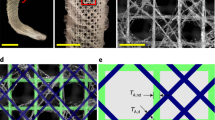Abstract
Knowledge of the structure–property–function relationships of dermal scales of armoured fish could enable pathways to improved bioinspired human body armour, and may provide clues to the evolutionary origins of mineralized tissues. Here, we present a multiscale experimental and computational approach that reveals the materials design principles present within individual ganoid scales from the ‘living fossil’ Polypterus senegalus. This fish belongs to the ancient family Polypteridae, which first appeared 96 million years ago during the Cretaceous period and still retains many of their characteristics. The mechanistic origins of penetration resistance (approximating a biting attack) were investigated and found to include the juxtaposition of multiple distinct reinforcing composite layers that each undergo their own unique deformation mechanisms, a unique spatial functional form of mechanical properties with regions of differing levels of gradation within and between material layers, and layers with an undetectable gradation, load-dependent effective material properties, circumferential surface cracking, orthogonal microcracking in laminated sublayers and geometrically corrugated junctions between layers.
This is a preview of subscription content, access via your institution
Access options
Subscribe to this journal
Receive 12 print issues and online access
$259.00 per year
only $21.58 per issue
Buy this article
- Purchase on Springer Link
- Instant access to full article PDF
Prices may be subject to local taxes which are calculated during checkout





Similar content being viewed by others
References
Hoedeman, J. J. Naturalists Guide to Fresh Water Aquarium Fish (Sterling Publishing Co., Oak Tree Press Co., New York, London, and Sydney, 1974).
Colbert, E. H. Evolution of the Vertebrates: A History of Backboned Animals Through Time (Wiley, New York, 1955).
Miller, H. The Cruise of the Betsy or Summer Holiday in the Hebrides with Rambles of a Geologist or Ten Thousand Miles of Fossiliferous Deposits of Scotland (Gould and Lincoln, Boston, 1857).
Romer, A. S. Eurypterid influence on vertebrate history. Science 78, 114–117 (1933).
Ørvig, T. in Proc. 4th Nobel Symp. (ed. Ørvig, T.) 373–397 (Almqvist and Wiskell, Stockholm, 1968).
Long, J. H. & Nipper, K. S. The importance of body stiffness in undulatory propulsion. Am. Zool. 36, 678–694 (1996).
Raschi, W. & Tabit, C. Functional aspects of placoid scales: A review and update. Aust. J. Mar. Freshw. Res. 43, 123–147 (1992).
Anderson, P. S. L. & Westneat, M. W. Feeding mechanics and bite force modelling of the skull of Dunkleosteus terrelli, an ancient apex predator. Biol. Lett. 22, 76–79 (2007).
Arciszewski, T. & Cornell, J. in Bio-Inspiration: Learning Creative Design Principia (ed. Smith, I. F. C.) (Springer, Berlin, 2006).
Weiner, S. & Addadi, L. Design strategies in mineralized biological materials. J. Mater. Chem. 7, 689–702 (1997).
Gao, H., Ji, B., Jager, I. L., Arzt, E. & Fratzl, P. Materials become insensitive to flaws at nanoscale: Lessons from nature. Proc. Natl Acad. Sci. USA 100, 5597–5600 (2003).
Buehler, M. J. Molecular nanomechanics of nascent bone: Fibrillar toughening by mineralization. Nanotechnology 18, 1–9 (2007).
Currey, J. D. The design of mineralised hard tissues for their mechanical functions. J. Exp. Biol. 202, 3285–3294 (1999).
Fantner, G. E. et al. Sacrificial bonds and hidden length dissipate energy as mineralized fibrils separate during bone fracture. Nature Mater. 4, 612–616 (2005).
Tai, K., Dao, M., Suresh, S., Palazoglu, A. & Ortiz, C. Nanoscale heterogeneity promotes energy dissipation in bone. Nature Mater. 6, 454–462 (2007).
Balooch, G. et al. Evaluation of a new modulus mapping technique to investigate microstructural features of human teeth. J. Biomech. 37, 1223–1232 (2004).
Bruet, B. J. F. et al. Nanoscale morphology and indentation of individual nacre tablets from the gastropod mollusc Trochus niloticus. J. Mater. Res. 20, 2400–2419 (2005).
Raabe, D., Sachs, C. & Romano, P. The crustacean exoskeleton as an example of a structurally and mechanically graded biological nanocomposite material. Acta Mater. 53, 4281–4292 (2005).
Barbakadze, N., Enders, S., Gorb, S. & Arzt, E. Local mechanical properties of the head articulation cuticle in the beetle Pachnoda marginata (Coleoptera, Scarabaeidae). J. Exp. Biol. 209, 722–730 (2006).
Ortiz, C. & Boyce, M. C. Bioinspired structural materials. Science 319, 1053–1054 (2008).
Daget, J., Gayet, M., Meunier, F. J. & Sire, J.-Y. Major discoveries on the dermal skeleton of fossil and recent polypteriforms: A review. Fish Fisheries 2, 113–124 (2001).
Kodera, H. et al. Jurassic Fishes: Selection, Care, Behavior (T. F. H. Publications, New Jersey, 1994).
Carroll, R. L. Vertebrate Paleontology and Evolution (W. H. Freeman and Company, New York, 1988).
Oliver, W. C. & Pharr, G. M. An improved technique for determining hardness and elastic modulus using load and displacement sensing indentation experiments. J. Mater. Res. 7, 1564–1583 (1992).
Ørvig, T. in Structural and Chemical Organization of Teeth (ed. Miles, A. E.) Ch. 2, 45–110 (Academic, New York, 1967).
Meunier, F. J. Recherches histologiques sur le squelette dermique des Polypteridae. Archives de Zoologie Expérimentale et Générale 122, 279–295 (1980).
Meunier, F. J. Os cellulaire, os acellulaire et tissus dérivés chez les Ostéichthyens: Les phénomènes de l’acellularisation et de la perte de minéralisation. L’Année Biologique 26, 201–233 (1987).
Sire, J.-Y. From ganoid to elasmoid scales in the Actinopterygian fishes. Neth. J. Zool. 40, 75–92 (1990).
Jayachandran, R., Boyce, M. C. & Argon, A. S. Design of multilayer polymeric coatings for indentation resistance. J. Comput.-Aided Mater. Design 2, 151–166 (1995).
Markey, M. J., Main, R. P. & Marshall, C. R. In vivo cranial suture function and suture morphology in the extant fish Polypterus: Implications for inferring skull function in living and fossil fish. J. Exp. Biol. 209, 2085–2102 (2006).
Lauder, G. V. Evolution of the feeding mechanism in primitive actinopterygian fishes; a functional anatomical analysis of Polypterus, Lepisosteus, and Amia. J. Morphol. 163, 283–317 (1980).
Gemballa, S. & Bartsch, P. Architecture of the integument in lower Teleostomes: Functional morphology and evolutionary implications. J. Morphol. 253, 290–309 (2002).
Tai, K., Ulm, F.-J. & Ortiz, C. Nanogranular origins of the strength of bone. Nano Lett. 6, 2520–2525 (2006).
Gupta, H. S. et al. Nanoscale deformation mechanisms in bone. Nano Lett. 5, 2108–2111 (2005).
Tai, K., Qi, H.-J. & Ortiz, C. Effect of mineral content on the nanoindentation properties and nanoscale deformation mechanisms of bovine tibial cortical bone. J. Mater. Sci.: Mater. Med. 16, 947–959 (2005).
Nalla, R. K., Kinney, J. H. & Ritchie, R. O. Mechanistic fracture criteria for the failure of human cortical bone. Nature Mater. 2, 164–168 (2003).
Imbeni, V., Kruzic, J. J., Marshall, G. W. & Ritchie, R. O. The dentin–enamel junction and the fracture of human teeth. Nature Mater. 4, 229–232 (2005).
Suresh, S. Graded materials for resistance to contact deformation and damage. Science 292, 2447–2451 (2001).
Shimizu, D. & Macho, G. A. Functional significance of the microstructural detail of the primate dentino-enamel junction: A possible example of exaption. J. Human Evolut. 52, 103–111 (2007).
Humphries, J. Polypterus senegalus, online digital morphology. Accessed June 1, 2007 at <http://digimorph.Org/specimens/polypterus_senegalus/whole/> (Michigan Museum of Zoology) (ummz 195008). (2003).
Acknowledgements
The authors thank the MIT Department of Materials Science and Engineering Nanomechanical Testing Facility, the National Science Foundation MIT Center for Materials Science and Engineering, the Centre de Recherche de la Matière Condensée et des Nanosciences (CRMC-N) at Université de Marseille-Luminy, France, the MIT International Science and Technology Initiatives—France Seed Fund and the US Army through the MIT Institute for Soldier Nanotechnologies (contract number DAAD-19-02-D0002), as well as R. Jensen and T. Weerasooriya from the US Army Research Laboratory and T. Imholt from Raytheon for discussions. The content does not necessarily reflect the position of the government and no official endorsement should be inferred. The authors would also like to thank E. Chen, J. H. Choi, J. Kim, J. Y. Mao, M. D. Mascaro and E. R. Pfeiffer for assisting with initial sample preparation and preliminary data, A. Baronnet for assistance with electron microscopy and G. Lauder (Harvard University) for carrying out the scale-removal surgery.
Author information
Authors and Affiliations
Corresponding author
Rights and permissions
About this article
Cite this article
Bruet, B., Song, J., Boyce, M. et al. Materials design principles of ancient fish armour. Nature Mater 7, 748–756 (2008). https://doi.org/10.1038/nmat2231
Received:
Accepted:
Published:
Issue Date:
DOI: https://doi.org/10.1038/nmat2231
This article is cited by
-
Templated freezing assembly precisely regulates molecular assembly for free-standing centimeter-scale microtextured nanofilms
Science China Chemistry (2023)
-
Bending response and energy dissipation of interlayer slidable friction booklike-plates
Acta Mechanica Sinica (2023)
-
Mechanically robust supramolecular polymer co-assemblies
Nature Communications (2022)
-
Fish-inspired flexible protective material systems with anisotropic bending stiffness
Communications Materials (2021)
-
Bending behavior of biomimetic scale covered beam with tunable stiffness scales
Scientific Reports (2020)



